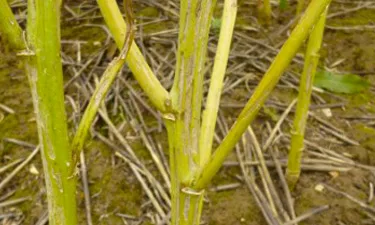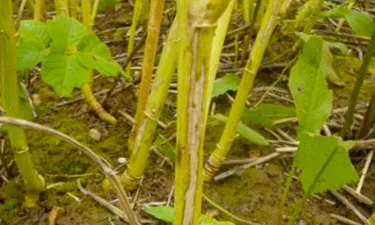
Verticillium Wilt Brassicas OSR
Verticillium longisporum

Verticillium longisporum
Pathogen
Fungus
Hosts
Oilseed Rape, brassicas and cruciferous weeds such as such as shepherd`s purse and charlock.
Symptoms
Although infection occurs mainly in autumn, from soil-borne resting spores called microsclerotia, most symptoms are usually only seen in crops close to harvest. Initially there is yellowing and later bronzing up the side of the stem extending from the stem base to the upper branches. Typically only part of the stem shows symptoms, but during severe infections the whole stem can be affected.
Both Phoma and Verticillium symptoms can be present in the same plant. The extension of symptoms in the branches distinguishes Verticillium from Phoma lesions. Verticillium may produce yellowing symptoms on one half of the leaf, but this does not appear to be a very reliable diagnostic feature.
Grey or black discolouration can be found underlying the vertical stripes and this becomes more pronounced as plants senesce or ripen. The grey colour is due to the formation of new microsclerotia as the pathogen develops outside the vascular tissues.
Development
The Verticillium Wilt pathogen is a specialised species that affects brassicas. Microsclerotia are capable of long term survival in soil and clean fields can become infested by the introduction of infected seed, soil or plant debris from fields where crops have suffered previously. These microsclerotia germinate in autumn and the hyphae colonise the plant's root system, but at this stage there are no symptoms. In spring during stem extension, the pathogen spreads through the vascular system and colonises the aerial parts resulting in the development of stem symptoms.
Favourable Factors
Warm spring conditions are favourable for the spread of Verticillium through the plant.
Importance
Verticillium Wilt was first diagnosed in the UK in 2007 and is currently the focus of research to better understand the disease and potential control measures both cultural and chemical. Recent surveys have confirmed cases as far north as Yorkshire but the most seriously affected areas are in the east and the south east of England.
Control
There is some evidence of differences in varietal susceptibility to Verticillium Wilt and plant breeders should be consulted for information about their varieties. Further work is required to define the benefits of using resistant varieties
Rotation of brassica crops is likely to remain an important method for control. At low risk sites, a gap between brassicas of four years is advised, but where Verticillium risks are high, a much longer rotation may be required.
Very early sowing should be avoided. Strict hygiene measures are needed to prevent movement of soil and microsclerotia on machinery and other farm equipment to clean fields. Seed from infected crops should not be used as it may be contaminated with Verticillium
Work is currently underway to study the potential role of fungicides in combating this disease but currently there are no products with approval for its control.

Verticillium (Photo S. Wilson)

Close up

Symptoms on the stem
The Verticillium Wilt pathogen is a specialised species that affects brassicas. Microsclerotia are capable of long term survival in soil and clean fields can become infested by the introduction of infected seed, soil or plant debris from fields where crops have suffered previously. These microsclerotia germinate in autumn and the hyphae colonise the plant's root system, but at this stage there are no symptoms. In spring during stem extension, the pathogen spreads through the vascular system and colonises the aerial parts resulting in the development of stem symptoms. Warm spring conditions are favourable for the spread of Verticillium through the plant.

Verticillium infected OSR stems

Verticillium infected OSR stems
Although infection occurs mainly in autumn, from soil-borne resting spores called microsclerotia, most symptoms are usually only seen in crops close to harvest. Initially there is yellowing and later bronzing up the side of the stem extending from the stem base to the upper branches. Typically only part of the stem shows symptoms, but during severe infections the whole stem can be affected.
Both Phoma and Verticillium symptoms can be present in the same plant. The extension of symptoms infor the branches distinguishes Verticillium from Phoma lesions. Verticillium may produce yellowing symptoms on one half of the leaf, but this does not appear to be a very reliable diagnostic feature.
Grey or black discolouration can be found underlying the vertical stripes and this becomes more pronounced as plants senesce or ripen. The grey colour is due to the formation of new microsclerotia as the pathogen develops outside the vascular tissues.
There is some evidence of differences in varietal susceptibility to Verticillium Wilt and plant breeders should be consulted for information about their varieties. Further work is required to define the benefits of using resistant varieties
Rotation of brassica crops is likely to remain an important method for control. At low risk sites, a gap between brassicas of four years is advised, but where Verticillium risks are high, a much longer rotation may be required. Very early sowing should be avoided. Strict hygiene measures are needed to prevent movement of soil and microsclerotia on machinery and other farm equipment to clean fields. Seed from infected crops should not be used as it may be contaminated withVerticillium.
Work is currently underway to study the potential role of fungicides in combating this disease but currently there are no products with approval for its control.


